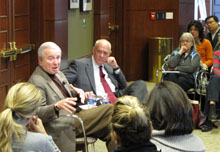
February 2, 2010 — “Why not?” is the question that lies at the foundation of Google’s engineering, said Ken Auletta in a Shorenstein Center discussion about his new book Googled: The End of the World as We Know It.
Auletta, who writes the Annals of Communications column for The New Yorker, described a landscape where “engineer is king,” and “central to Google’s success.” Working with the belief that “the old ways of doing things are inefficient,” engineers are able to envision new ways of thinking about how information is dispersed. Why pay for a Super Bowl ad on TV without knowing who is watching? Auletta said that by asking this question, Google engineers came up with a way to sell ads and track exactly which users were targeted.
According to Auletta, Google ads bring in more than $21 billion a year — 40% of all online ads — “equal to all of the consumer advertising in all the consumer magazines in the U.S., more than all advertising in broadcast networks”; nearly all the advertising in newspapers, too.
With its slogan, “Don’t be evil,” along with its policy of “not milking” advertisers and keeping the user’s interest paramount, “Google’s success is based on trust,” said Auletta. “They are not cold businessmen; they are cold engineers.” Google’s founders understand that a good search engine relies on good information.
Yet the “information optimists” who created Google, Auletta said, are being compelled by powerful forces as the U.S. and Chinese governments to make judgments relating to content, privacy and copyright.
For now, the executives at Google want to provide users with useful, searchable information. But Auletta noted that as Google Search slows down and the need for revenue increases, the question will become, who is the customer: the user or the advertiser? And Google is not alone in this quandary. Engineers in both the “traditional world” (print media) and the “new world” (Google, YouTube, and others) are looking for new ways to charge for content, “and that’s hopeful,” said Auletta.
This article was written by Janell Sims and the photos taken by Leighton Walter Kille, both of the Shorenstein Center.

